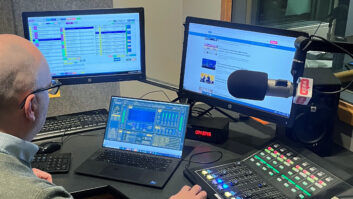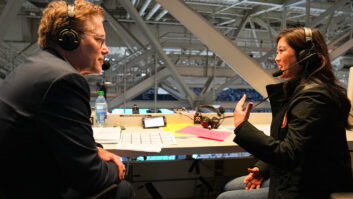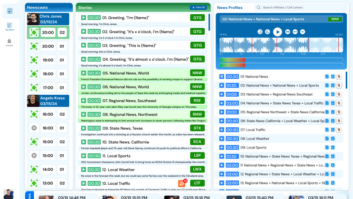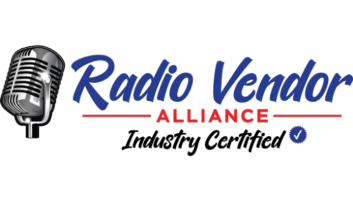It’s all about the Content
Mar 1, 2004 12:00 PM, By Gordon Carter, CPBE
For several years National Public Radio (NPR) has been on the leading edge of satellite audio distribution. Its first satellite distribution system was a C-band analog single channel per carrier (SCPC) system established in the 1970s. As an adjunct to this system, NPR instituted the DACS system using one-way data transmission on an analog channel. In the 1990s, that system was built on while the analog SCPC system was replaced with a digital system. Then the DACS system was replaced with the Satellite Operating Support System (SOSS). The SOSS system includes DACS as well as the ability to provide some level of remote control and automation.
NPR has now announced plans for its new Content Depot. The pieces are being put together to bring the plan to fruition. The plan is for the Content Depot to eventually replace the distribution system currently being used. At this time, NPR expects to begin parallel operation of the Content Depot and the existing system in November 2004, with complete conversion of operations by the end of 2005.
The sum of the parts
The Content Depot is a multifaceted programming, marketing and distribution concept comprised of several varied but integrated systems. From an interactive Web-based system for program marketing to an IP-based satellite distribution system to complete integration with automation systems, the Content Depot takes advantage of current off-the-shelf technology. NPR has attempted to use as much off-the-shelf equipment as possible to keep the capital costs to a minimum. Also, with the rapid pace of changing technology, flexibility is an important element of the plan.
To explain the concepts and implementation of the Content Depot, let’s follow the complete life cycle of a program or program series.
As a program producer develops a concept for a program or program series, he enters general program information, including audio samples, into the Content Depot via a Web interface. Stations that have expressed previous interest in this type of program will be notified automatically, and the audio sample will be available online for preview. The station, from the NPR website, can listen to and download programs, promos and associated materials such as bios and photos. This provides producers with a centralized and searchable location for marketing and storing programs and associated materials. It also supplies producers with a venue to test program concepts and ascertain possible interest.
As the audio program is developed, the producer can enter detailed information about the program into the Content Depot. NPR distribution staff will schedule the program for distribution, confirm the schedule and track and store the associated audio when it becomes available. Stations that have expressed an interest will be alerted to the schedule and can subscribe to the program, series or a single episode at any time prior to transmission.
The Content Depot will allow stations to subscribe to programs or series directly through the Content Depot via the Web. The station can then establish its local schedule and routing instructions during the subscription process. The Content Depot then adds the station to the distribution address list for the program. Producers will be able to view the list of subscribed stations at any time during the process.
Once the program is ready for distribution, the producer can send it to the Content Depot in one of several ways. He can upload a digital file through a Web interface. He can stream or upload the program from a system Point of Presence (called an uplink in the current system). He can also mail physical media to the Content Depot staff to be entered into the system. The digital file can then be captured and stored for later distribution. By maintaining the material in digital form as much as possible and using the above upload methods, greater efficiency is achieved in terms of transfer time and convenience of transfer. Transfers can be done when convenient without having to wait for a scheduled time, and transcoding (encode-decode-encode cycles) can be minimized.
When the time comes for transmission, the audio file and its metadata are transmitted. Metadata is a fairly new term, meaning information (data) that goes with a piece of digitized content. In other words, it is data about the data. It may include a description, subject heading and file format. As this information is defined and standardized the information can then be easily indexed, cataloged and searched.
Live programs are fed directly to the Content Depot, skipping the upload step above. Live programs are received by the stations and can be stored or routed directly to air. Stored programs (those that are not live) can be held in the stations’ Content Depot equipment until copied to the stations’ own automation system. Stored programs must be copied from the LAN-connected receiver to the station’s audio storage system for playback. Stations with Internet connectivity will automatically confirm the status of the file transfer with the Content Depot. This will be done using IP (Internet protocol) over satellite. The system can check for errors in transmission and notify the system and even retransmit the program if needed. If a program is missed, it can be downloaded via the Internet if the program is short enough.
At the scheduled time, stored programs are decoded and streamed from the station’s storage in analog or digital format (whichever the station needs for its system) along with any associated automation control cues. The Content Depot provides the producer with a listing of stations that have aired the program. It also provides program directors with a listing of all programs aired by the station.
Routing and distribution
The audio distribution system will be a wideband IP service. Individual stations will be provided with two receivers (one for backup) and a separate audio decoder stack for live programs (streams) that is connected to the LAN. Live programs will be fed in real time, just as they are now, and the receivers drop a data stream on the LAN with all the live audio packets for the audio decoder cards to process. The current plan is to provide four stereo analog and digital outputs per station that can then be routed through the station’s audio system. Programs and program elements intended for later playback will be delivered as files that can be temporarily stored on hard drives in the satellite receivers and then copied to the station’s storage system through the LAN. Local automation systems will then be able to retrieve the files and transfer them so they can be played through the automation system. NPR is working with the major providers of automation systems to ensure a seamless interface.
The many elements of the Content Depot are based on the concepts of asset management. Asset management systems store audio files, program elements and metadata in a centralized location. This concept can be expanded to include video and still picture elements for those operations that use these elements.
The current system depends on information being sent from program producers to the individual stations to distribute this information. As the Content Depot catalog is developed and comes online, stations will be able to browse through all of the options available to them at one place. They will be able to view program schedules, content and other information about the programs at their leisure, printing hard copies of only what they need. Electronic capture of promotional information, such as photos and bios, will make production of local programming schedules easier and faster.
As the system develops and equipment is deployed, most of the existing hardware for the NPR distribution system will be replaced. The satellite dishes will remain, and most stations have already converted to LNBs instead of LNAs. The satellite receivers, SOSS system and all ancillary equipment will be replaced. The new equipment will provide a bridge between the satellite system and the station’s automation system and computer network. Stations without an automation system will be able to use a rudimentary system based on the NPR equipment.
Getting started
NPR has begun the transition to the Content Depot. As noted before, many downlinks have already been upgraded to newer technology. WebDACS users have seen a more Web-friendly platform with better search and archive functions. The STC has already begun accepting delivery of audio via FTP (file transfer protocol) on the Internet. The PRSS.org website has been redesigned to make services and information easier to find.
All member stations will be provided with two receivers: one for live broadcasts and the other for stored programs. Because the receivers are all under IP control, the two receivers can do the job of several existing receivers. The receivers will be manufactured by International Datacasting Corporation (IDC) of Ottawa, Ontario. The transition should be relatively easy for most stations, assuming their existing satellite system is in good condition and has an L-band output.
To help keep users and member stations informed of the progress, NPR has conducted several meetings at trade conventions and held interconnects on the NPR satellite system. NPR will hold sessions at the Public Radio Engineers’ Conference preceding NAB2004 as well as conducting operations workshops in conjunction with the regional station meetings this fall.
Carter is chief engineer of WFMT-FM, Chicago.
The most up-to-date information can be obtained on the NPR website at www.PRSS.org. For specific questions contact Marty Bloss, director of technology, at 202 513-2676 or via e-mail at [email protected].












